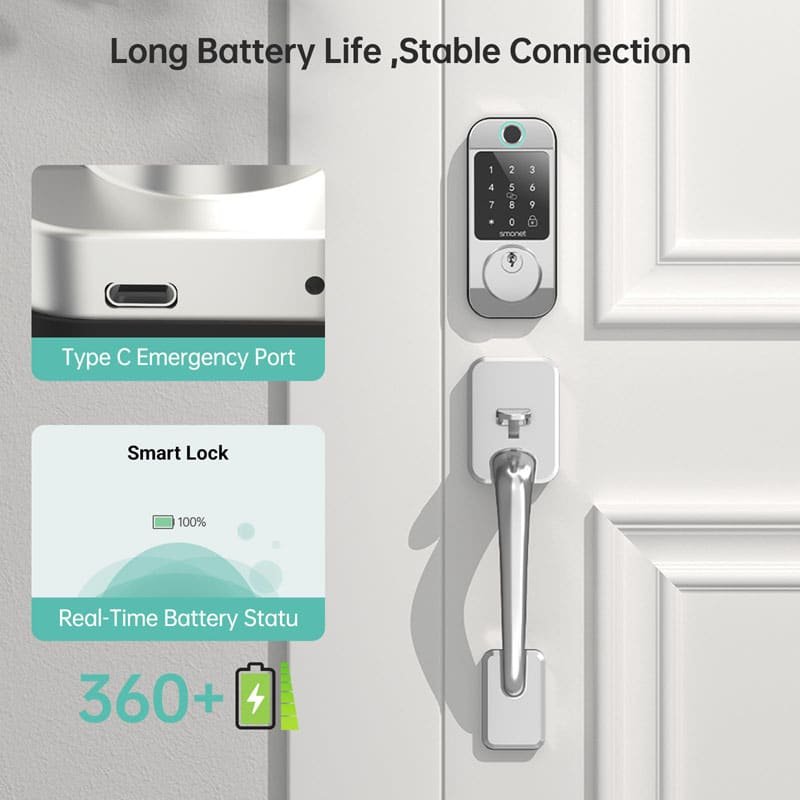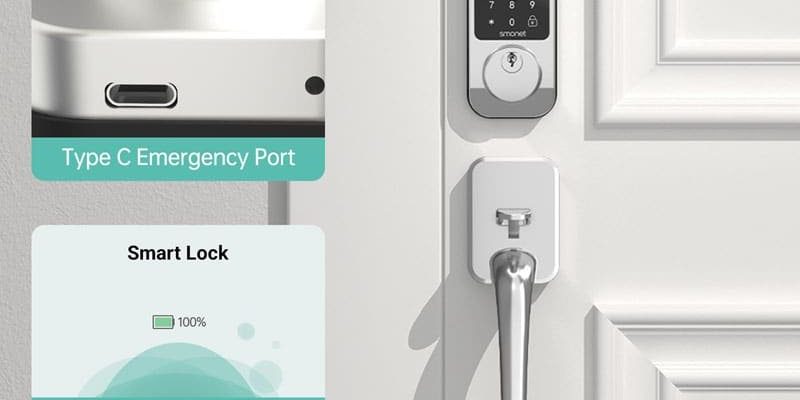
Here’s the thing: most smart deadbolts aren’t exactly energy hogs, but they still run on AA or 9V batteries that don’t last forever. Whether your lock uses Bluetooth, Wi-Fi, or Zigbee, keeping it happy (and powered up) is all about understanding what drains its battery, and making a few tweaks you can actually stick with. Honestly, a few good habits can mean the difference between months of reliable use and that dreaded, midweek “battery critically low” alert.
Let me walk you through practical ways to extend the battery life of your smart deadbolt—without needing a degree in engineering or endlessly fiddling with settings. These tips are based on real-life use with popular locks, and a good chunk of common sense.
Know What Drains Your Smart Deadbolt’s Battery
You might be wondering why your smart deadbolt seems to guzzle batteries faster than your TV remote. It’s not just about unlocking your door—there’s a lot going on under the hood. Modern locks like August or Kwikset Kevo handle more than just turning the bolt. They constantly sync with your phone, maintain a connection to Wi-Fi, support voice commands, and sometimes, light up or chirp to keep you in the loop.
Here’s the main culprit: frequent wireless activity. Every time your lock tries to sync, pair, or reset its connection—say, when you use your phone to open it remotely—it uses a burst of power. Some locks poll the network every few seconds, especially those with built-in Wi-Fi. It’s like a kid flicking a light switch on and off all day.
Mechanical resistance matters too. If your door is misaligned or sticky, the deadbolt motor has to work overtime just to lock and unlock. This extra strain can cut your battery life in half before you even realize what’s happening. Keeping your lock and door in good shape isn’t just about security, but also about not burning through batteries.
Pick the Right Batteries for Your Smart Lock
Not all batteries are created equal—especially when it comes to smart deadbolts. Many people grab the cheapest pack of AAs they find, but honestly, this is one of those moments where quality pays off. Most brands, like Schlage or Yale, recommend alkaline batteries (like Duracell or Energizer). Avoid cheap, off-brand batteries, and skip rechargeables unless your manual says they’re okay.
Here’s why: rechargeable (NiMH) batteries often have a lower voltage, and your deadbolt may think they’re dead long before they’re actually empty—triggering false low-battery warnings. Lithium batteries (like Energizer Ultimate Lithium) can last even longer but sometimes confuse battery meters, so only use them if your lock’s manual lists them specifically.
You might be tempted to buy “super heavy duty” or “ultra-long-life” batteries, but don’t get fooled by flashy packaging. Stick to brand-name alkaline batteries, check the expiration date, and always replace all batteries together instead of mixing old with new. Consistency means fewer surprise sync or reset issues down the line.
Optimize Wireless Settings for Less Drain
Let’s talk about that invisible stuff: Wi-Fi, Bluetooth, and Z-Wave connections. These are what make your smart deadbolt…well, smart. But they’re also what drain your battery fastest. Some locks, like August, offer both Bluetooth and Wi-Fi connections, and each has trade-offs.
If your lock lets you choose between Bluetooth, Zigbee, or Wi-Fi, stick with the lowest-power option that still does everything you need. Bluetooth uses the least energy, while Wi-Fi eats through batteries faster. If you rarely unlock your door from miles away, consider turning off Wi-Fi or remote access in your lock’s app. It might sound counterintuitive, but a little less remote control can mean many more months between battery swaps.
Here’s another tip: limit the number of devices paired with your lock. If everyone in the house has the app installed, or if you keep adding new phones or smart displays, your lock spends more time syncing. Each extra device is another handshake, and every handshake costs a little juice.
Take Care of Your Door and Lock Hardware
Sometimes it’s not the electronics—it’s the old-fashioned stuff that drains your battery. If your deadbolt feels sticky, grinds, or sometimes doesn’t fully retract, your lock’s motor has to work harder every single time. That means more power used, and a battery that flames out early.
Start by making sure your door is properly aligned. If it sags or the deadbolt doesn’t line up perfectly, use a screwdriver to adjust the strike plate. If you feel resistance when manually locking the door, that’s a red flag. A quick shot of graphite or silicone-based lubricant (never oil) can help keep things moving smoothly without gunking up the works.
Don’t forget to check for weather stripping or swelling wood, especially if your door is exposed to the elements. A sticky lock in summer may work fine in winter, and vice versa. All of this helps your smart deadbolt operate efficiently—which means it only uses as much battery as it really needs.
Keep Firmware and Apps Updated
It’s tempting to ignore those little update prompts from your smart lock’s app, but firmware updates are actually one of the best ways to extend battery life. Manufacturers like Yale, August, and Schlage are always tweaking their code to fix bugs, optimize wireless sync, and improve battery efficiency. Sometimes a single update can add months of life to your lock.
Updates can also patch security holes and fix issues where your lock tries to constantly reconnect (a notorious battery killer). To make updates easier, set your app to auto-update or schedule regular check-ins every few months. If you have a Wi-Fi bridge or remote, check for firmware updates there, too.
Honestly, ignoring updates is kind of like driving around on bald tires—it works until it really, really doesn’t. If your lock starts to drain batteries faster, a quick check for app or firmware updates is one of the simplest troubleshooting steps.
Adjust Your Usage Habits
Here’s a trick most people overlook: the way you use your smart lock matters. Are you constantly checking if the door is locked, or asking your smart speaker to “lock the front door” a dozen times a day? Every time your lock wakes up to answer a status check or execute a command, it uses a bit of power.
Try to minimize “just checking” from your phone or remote. Instead, build a habit of locking/unlocking when you actually need to. Disable unnecessary alerts or status pings, especially if they’re set to frequent intervals. Most smart deadbolts, like the Kwikset Halo or Level Lock, let you adjust notification settings in their app—less chatter means longer battery life.
Another tip: use physical keys when possible, especially if you’re home for a while. It might feel old-school, but using the key bypasses the motor and saves a little battery every time. Save the “remote unlock” party trick for when you really need it.
Monitor Battery Level and Replace Proactively
Most smart deadbolts include battery percentage displays in their apps or beep when the battery is getting low. Don’t ignore these warnings. The last 10% of battery life can drop much faster than you’d expect, especially if the temperature changes or the lock gets heavy use.
Set a calendar reminder every few months to check battery status in the app. Some brands, like Yale or August, even let you set up notifications for low battery. And here’s a pro tip: keep a spare set of compatible batteries near the door or in your entryway drawer. That way, you’re never stuck hunting for the right pack when your lock decides it’s time for a swap.
If you start seeing battery levels drop unexpectedly (say, from 80% to 20% in a week), it could be a sign of a sync or firmware issue, mechanical resistance, or even a faulty battery batch. Quick troubleshooting can save you from getting locked out at the worst possible moment.
Consider Alternative Power or Backup Options
If you really want to stretch out the time between battery swaps—or you travel often and worry about battery failures—look into backup options. Some deadbolts, like the Yale Assure SL, allow for an emergency 9V battery jump-start right from the outside. This feature lets you “wake up” a dead lock just long enough to get inside.
A handful of smart locks now offer rechargeable battery packs or even hardwired power options via doorbell transformers. While these aren’t common on budget models, they’re worth considering if you never want to deal with battery changes again.
Universal remote modules or key fob remotes can be gentler on your lock’s battery than always using a Wi-Fi app, especially for less tech-savvy family members. Just make sure the accessories you choose are compatible with your deadbolt and don’t cause extra drain by constantly trying to connect or sync.
Smart deadbolts were designed for convenience, but a little bit of regular maintenance and a few tweaks to your daily habits make owning one truly stress-free.
When you understand what’s actually eating up your smart lock’s battery, it’s easy to take charge (pun intended) and avoid the hassle of surprise dead batteries. From choosing the right batteries and keeping your door hardware running smoothly to managing your lock’s wireless behavior and staying on top of updates, each habit adds up to a smart deadbolt that just works—quietly and reliably, every time you come home.
